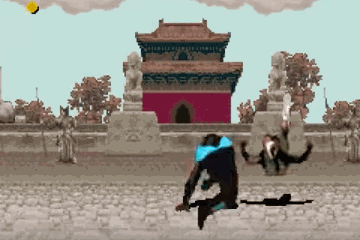Mortal Kombat II behind the glass case
Part of Book Notes: Console Wars
“Let me show you something.”
I stepped aside and an older kid—picture young John Connor—took the joystick. A few moments later Sub-Zero ripped someone’s head off with their spine attached. Awesome.
This was my first time seeing a fatality in Mortal Kombat. Apparently some parents didn’t think this was great, so the first Mortal Kombat had sweat instead of blood. Except for the kids with a Genesis.
“Some sort of blood code,” Garske explained to Kalinske. “So when you buy the game, it comes without any of that over-the-top gore and violence. But then all you have to do in order to get the game to look just like it does in the arcades is enter a code. A combination of buttons and then boom—blood everywhere.”
So on the SNES when I’d try to rip a spine out, instead I’d see this:

“As long as the shattered body parts aren’t red ice, we’re Gucci.”
I made the last quote up. My point was going to be that the SNES had watered down fatalities. But… this seems pretty brutal too. But these seemed much tamer as a kid.
I remember being really aware of how the first game had sweat. Nobody was buying the SNES version and most of my friends were Nintendo kids. And that it was a big deal that the sequel would have blood without a code.
I have cloudy memories of going to an AAFES store with my brother and our parents to get Mortal Kombat II. And it was behind this glass case with a rating on it. (Though it wasn’t one of the ESRB ratings that would eventually come out.)
Anyway we got it and then played it. A lot. I remember seeing MKII the first time at an arcade in an airport. And someone (again, an older kid) had what looked like a strategy guide but it was just a bunch of printouts.
And these printouts had all the moves and fatalities. That might have been my first exposure to anything related to the internet.
Console Wars talks about the different approaches toward violence that SEGA and Nintendo took.